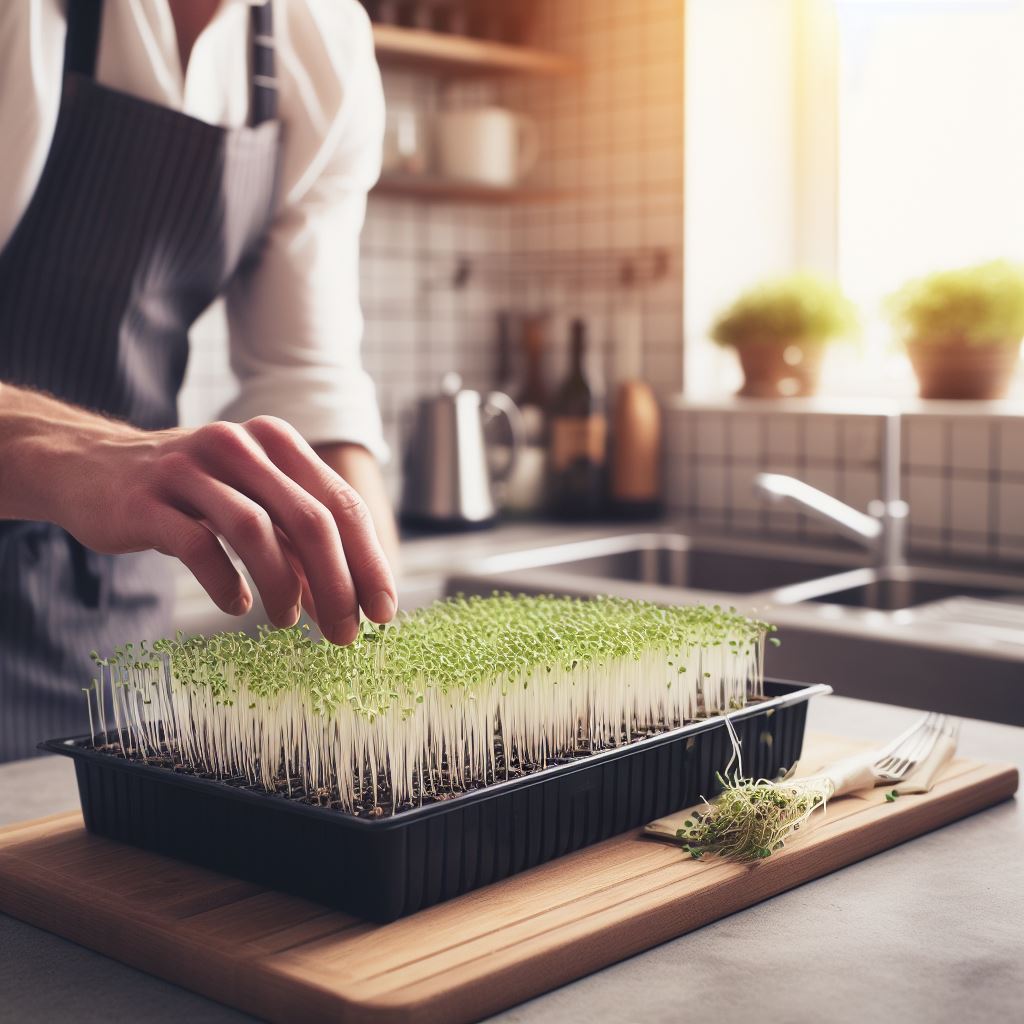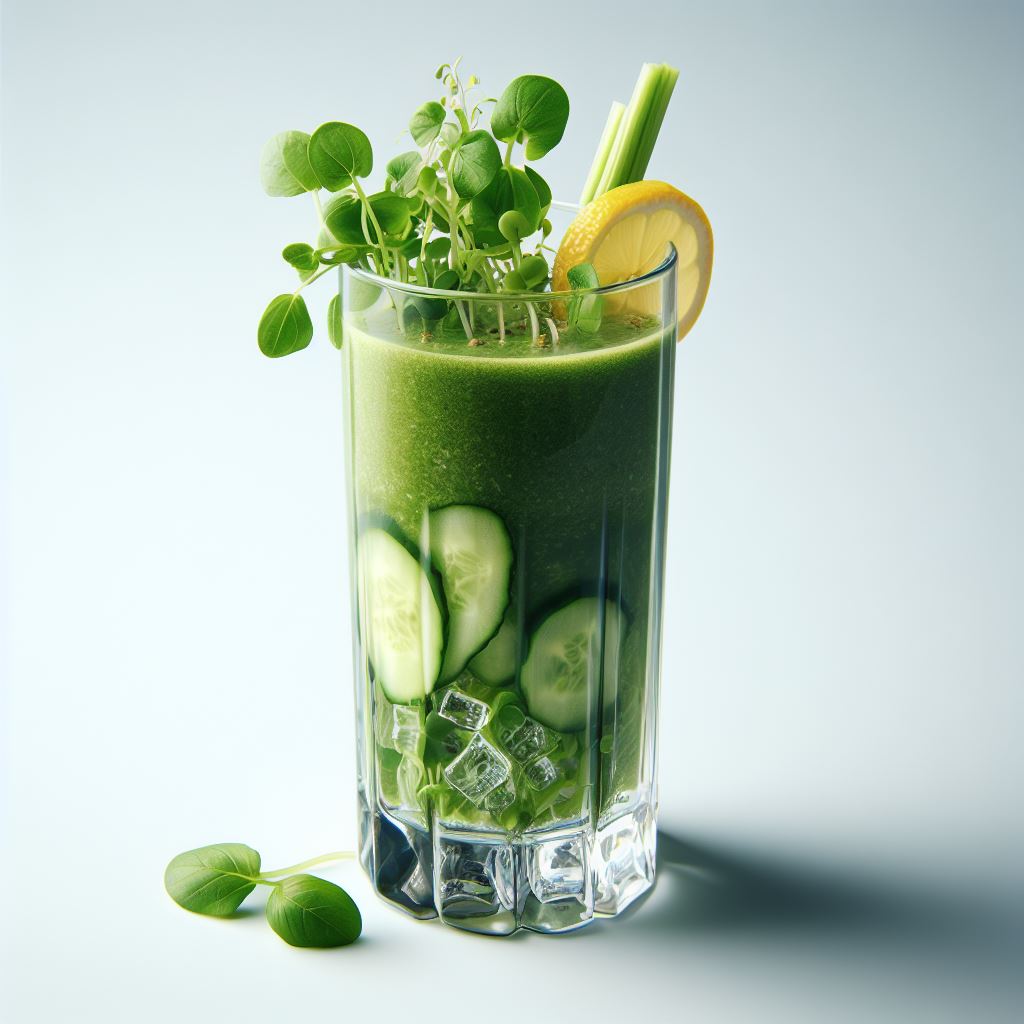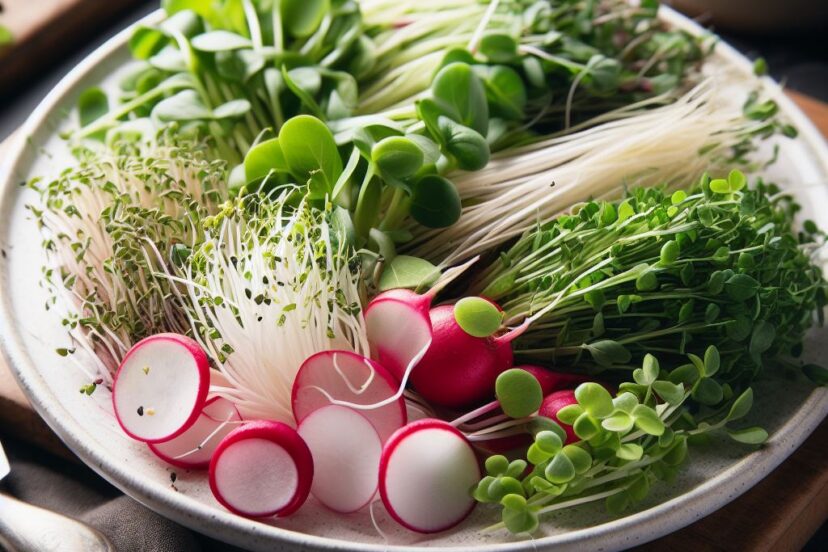Types of Microgreens: Unveiling a Diverse Range
Introduction to the different Types of Microgreens
Microgreens, the young, tender shoots of various vegetables and herbs, are poised at the intersection of flavor, nutrition, and convenience. Gaining popularity in recent years, these miniature greens have transcended their role as mere garnishes, emerging as nutritional powerhouses with the potential to transform your meals. In this comprehensive guide, we’ll embark on a journey into the world of the different Types of Microgreens, unveiling their diverse array, exploring their nutritional benefits, and offering practical insights into their cultivation and utilization.
A Brief History
Microgreens may seem like a recent trend, but their roots can be traced back centuries. Ancient civilizations, notably the Persians and Chinese, recognized the value of young, tender greens and incorporated them into their diets for their concentrated nutrients. Fast forward to today, and microgreens have found their way into the culinary repertoire of chefs, health enthusiasts, and home gardeners alike.
The Science Behind Microgreens
At the heart of Types of Microgreens’ nutritional potency lies their early stage of growth. During this phase, these tiny plants are packed with an abundance of essential vitamins, minerals, and antioxidants. Studies have shown that Types of Microgreens can contain up to 40 times the nutrient density of their mature counterparts, making them a valuable addition to any balanced diet.
Diversity in Flavor and Appearance
One of the remarkable aspects of types of microgreens is the wide range of flavors and textures they offer. From the mild peppery kick of arugula to the earthy richness of beet microgreens, each variety brings its own unique personality to the table. Additionally, their vibrant colors and delicate leaves make them not only a culinary delight but also an aesthetic pleasure.
Beyond Culinary Delights
While the various types of microgreens undoubtedly elevate the taste and visual appeal of dishes, their benefits extend far beyond the palate. Their nutrient-rich profiles contribute to improved digestion, strengthened immunity, and even weight management. This holistic approach to health makes microgreens an invaluable asset in any wellness-conscious lifestyle.
Why Opt for Microgreens?
Microgreens have become more than just a culinary trend; they’re a nutritional powerhouse with numerous advantages that make them a worthy addition to your diet.
Nutrient Density: A Green Treasure Trove
The early growth stage of microgreens is when they are most nutrient-dense. Packed with vitamins, minerals, and antioxidants, they offer a concentrated burst of goodness. For instance, a handful of broccoli microgreens can provide a significant portion of your daily recommended intake of vitamins and minerals.
Convenience at Your Fingertips
One of the greatest benefits of microgreens is their convenience. They can be grown easily at home, even in limited space, allowing you to have a fresh supply on hand whenever you need them. No need for trips to the grocery store – just harvest what you need, when you need it.
Culinary Versatility
Microgreens are incredibly versatile in the kitchen. Their tender, delicate leaves and vibrant flavors make them a delightful addition to a wide range of dishes. Whether tossed in salads, added to sandwiches, or used as a garnish for soups, main courses and on pizzas, microgreens bring a burst of freshness and nutrition to every bite.

Health Boosting Properties
Beyond their delicious taste, microgreens offer an array of health benefits. They are rich in antioxidants, which help protect your cells from damage caused by free radicals. Additionally, their high fiber content supports healthy digestion, making them a valuable addition to a balanced diet.
Sustainable and Cost-Effective
Growing your own microgreens not only ensures a fresh and sustainable source of nutrients but also helps reduce your environmental footprint. Plus, it’s a cost-effective way to enjoy these nutritional powerhouses, as the seeds are relatively inexpensive, and the yield is impressive.
Exploring the Diverse Types of Microgreens
Microgreens come in a wide array of flavors, colors, and textures, thanks to the diversity of plant species that can be grown in this form. Let’s delve into some of the most popular families and varieties.
1. Brassicaceae Family
This family includes well-known vegetables like broccoli and radishes. When harvested as microgreens, they offer a unique flavor profile that ranges from mild and slightly peppery to zesty and spicy.
a. Broccoli Microgreens
Broccoli microgreens are nutritional powerhouses, containing high levels of sulforaphane, a compound known for its anti-cancer properties. Their mild, slightly peppery flavor complements a wide range of dishes.
b. Radish Microgreens
Radish microgreens pack a spicy punch, adding a zesty kick to salads and sandwiches. They are a rich source of vitamin C, calcium, and potassium, providing a boost to your immune system.
c. Arugula Microgreens
Arugula microgreens offer a peppery, nutty flavor profile. They are a great source of vitamins A, C, and K, as well as folate and calcium. These greens are perfect for adding a unique twist to your salads.
2. Asteraceae Family
This family is known for its vibrant and diverse members, including sunflowers. When grown as microgreens, they offer a delightful nutty flavor and a crunchy texture.
a. Sunflower Microgreens
Sunflower microgreens are a good source of protein, vitamin E, and healthy fats. They have a mild, nutty flavor that pairs well with various dishes. These greens are known for their crunchy texture and rich nutrient profile.

3. Apiaceae Family
Featuring herbs like celery and dill, the Apiaceae family offers microgreens with distinct and fresh flavors reminiscent of their mature counterparts.
a. Celery Microgreens
Celery microgreens have a mild, fresh taste reminiscent of celery stalks. They are a good source of vitamin K, which is crucial for blood clotting and bone health. These greens are a versatile addition to salads and wraps.
b. Dill Microgreens
Dill microgreens offer a delicate, aromatic flavor similar to mature dill. They are rich in vitamins A and C, as well as calcium and iron. These greens are excellent for enhancing the flavor of seafood dishes.
4. Amaranthaceae Family
Amaranth microgreens belong to this family, offering a unique earthy flavor and a treasure trove of essential nutrients.
a. Amaranth Microgreens
Amaranth microgreens have a mild, earthy flavor and are loaded with essential nutrients like vitamin K, vitamin C, and folate. They make a nutritious addition to salads, sandwiches, and wraps. Additionally, their vibrant red and green leaves add an appealing visual element to your dishes.
5. Poaceae Family
Wheatgrass, belonging to the Poaceae family, is renowned for its high chlorophyll content, which is beneficial for detoxification.
a. Wheatgrass
Wheatgrass microgreens are known for their high chlorophyll content, which is beneficial for detoxification. They have a slightly sweet, earthy taste and are commonly used in juices and smoothies. Wheatgrass is a popular choice for those seeking a natural energy boost and enhanced detoxification.
6. Lamiaceae Family
This family boasts aromatic herbs, and when grown as microgreens, they offer an intense burst of flavor.
a. Basil Microgreens
Basil microgreens boast a concentrated basil flavor and are a rich source of vitamins A and K, as well as essential minerals. They are perfect for adding a burst of freshness to Italian dishes. Use basil microgreens in pestos, salads, or as a flavorful topping for pizzas and pastas.
A Green Thumb’s Guide: Cultivating Microgreens
Cultivating microgreens is a gratifying endeavor, and here’s how you can embark on it:
a. Picking the Perfect Container
Select a shallow container or tray equipped with drainage holes to ensure excess water doesn’t accumulate, safeguarding the roots from waterlogging.

b. Soil and Growing Medium Selection
Opt for a top-notch, well-draining soil or specialized microgreen growing medium. Avoid garden soil to sidestep potential pathogens or pests.
c. Lighting and Temperature: The Ideal Environment
Position your container in an area with indirect sunlight or under a grow light. Microgreens thrive in temperatures ranging from 60-75°F (15-24°C).
d. Nurturing with Water and Ensuring Humidity
Mist the soil gently to maintain consistent moisture without saturating it. A spray bottle is an effective tool for this purpose. Foster a humid environment by covering the container with a plastic lid or a damp cloth.
e. Harvesting and Storing the Bounty
Once the microgreens flaunt their first set of true leaves (usually within 7-14 days), they’re ready for harvest. A clean pair of scissors will do the job; snip just above the soil line. Rinse them delicately and pat dry before use. Any surplus microgreens can be stored in an airtight container in the refrigerator.
Culinary Adventures with Microgreens
The versatility of microgreens knows no bounds, offering a world of culinary possibilities:
a. From Salads to Sandwiches: A Versatile Addition
Enhance your favorite salads or elevate sandwiches and wraps with a generous handful of microgreens, imparting both flavor and nutrition.
b. Sip the Goodness: Smoothies and Juices with a Microgreen Twist
Blend microgreens into your morning smoothies or juices for an added nutritional boost, enriching your beverages with vitamins and minerals.

c. Elevate Every Dish: Microgreens as Garnishes and Toppings
Garnish soups, omelets, pizzas, and other dishes with microgreens, introducing bursts of color and flavor to every bite.
Nutritional Brilliance of Microgreens
a. Nutrient-Rich Powerhouses
Microgreens are veritable treasure troves of essential vitamins and minerals, making them a concentrated source of nutrition.
b. Antioxidant Arsenal: Safeguarding Cellular Health
These young greens are brimming with antioxidants that act as a defense against free radicals, safeguarding the integrity of your cells.
c. Digestive Wellness and Microgreens
The fiber content in microgreens supports healthy digestion, offering relief from common digestive discomforts.
d. Weight Management with Microgreens
Low in calories yet rich in nutrients, microgreens serve as satisfying additions to meals without contributing excess calories.
e. Strengthening the Body’s Defenses
The abundant vitamin and mineral content in microgreens fortifies your immune system, bolstering your resilience to illnesses.
Health Considerations and Precautions
a. Allergies and Sensitivities
For some individuals, specific types of microgreens may trigger allergies or sensitivities. Begin with small quantities to test for any adverse reactions.
b. Safeguarding Against Contaminants
To minimize the risk of harmful bacteria or pathogens, ensure that you use clean containers, soil, and water in your growing process.
Selecting and Preserving Microgreens
a. Discerning Quality Microgreens
When procuring microgreens, seek out vibrant, fresh greens with robust leaves. Avoid any signs of wilting, discoloration, or mold, as these indicate a decline in quality.
b. Proven Techniques for Prolonged Freshness
To extend the shelf life of your microgreens, store them in an airtight container lined with a paper towel. Keep them in the refrigerator, and they should stay fresh for up to a week.
Frequently Asked Questions (FAQs)
Is soil necessary for growing microgreens?
While soil is a traditional medium, hydroponic methods using alternatives like coconut coir or hydroponic mats are also viable. This approach can be space-efficient and reduces the risk of soil-borne diseases.
How soon can I expect my microgreens to be ready for harvest?
Most microgreens are ready for harvest within 7-14 days after germination, depending on the type and growing conditions.
Which microgreens are ideal for beginners?
For those just starting, radish, broccoli, and sunflower microgreens are forgiving choices. They are hardy and less sensitive to minor mistakes in care.
Can I freeze microgreens for later use?
While possible, freezing may alter their texture and flavor. For the best taste and nutrient content, it’s recommended to consume microgreens fresh.
What are common pitfalls when growing microgreens?
Common mistakes include overwatering, inadequate lighting, using poor-quality soil, and neglecting proper ventilation. Regular monitoring and adjustments are crucial for successful growth.
Conclusion: Your Microgreen Odyssey Continues
Embracing various types of microgreens in your culinary repertoire and as a nutritional powerhouse is an enriching journey. With a diverse palette of flavors and a treasure trove of nutrients, these young greens offer a multitude of health benefits. Whether you’re a seasoned gardener or a novice, cultivating and utilizing microgreens is an accessible and rewarding endeavor. So, why not embark on this journey to enhance your meals and elevate your well-being?
Remember, the world of microgreens is diverse, offering a wide range of flavors and nutrients. Experiment, have fun, and discover your favorite varieties. Happy growing and savoring!
Note: This guide is meant to provide general information and suggestions. For personalized advice and recommendations based on your specific health needs, consult with a healthcare professional or nutritionist.




